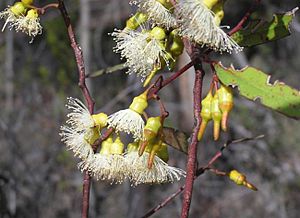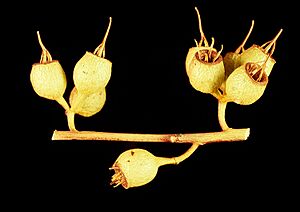Eucalyptus flocktoniae facts for kids
Quick facts for kids Merrit |
|
|---|---|
 |
|
| Flowers and buds of E. flocktoniae | |
| Scientific classification | |
| Genus: |
Eucalyptus
|
| Species: |
flocktoniae
|
| Synonyms | |
|
|
The merrit (scientific name: Eucalyptus flocktoniae) is a special type of tree or mallee (a small, bushy tree). It grows only in Western Australia. This plant is easy to spot with its smooth, shiny, silvery-grey bark. It has unique, long, curved adult leaves. Its flower buds have a prominent beak-like shape. When the flowers are gone, they leave behind fruit that looks like a small barrel or urn.
Contents
What the Merrit Looks Like
The Eucalyptus flocktoniae is a tree or a mallee. It can grow from about 2.5 to 15 meters tall. It has a special woody swelling at its base called a lignotuber. This helps it regrow after fires.
Its bark is smooth and can be silvery-grey or brownish. Sometimes, there's a little rough bark near the bottom. Young plants and new shoots growing from the base (called coppice regrowth) have leaves that are oval or egg-shaped. These leaves are about 40 to 75 mm long and 15 to 25 mm wide.
Adult leaves are long and curved. They are glossy green on both sides. These leaves are about 60 to 110 mm long and 8 to 20 mm wide. They grow on a stalk called a petiole, which is about 10 to 22 mm long.
Flowers and Fruit
The flower buds grow in groups of seven or nine. They appear where the leaves meet the stem (this spot is called a leaf axil). Each group of buds is on an unbranched stalk called a peduncle, which is 6 to 15 mm long. The individual buds are on smaller stalks called pedicels, about 3 to 6 mm long.
Mature buds are oval-shaped. They are about 11 to 18 mm long and 4 to 6 mm wide. They have a cap-like top called an operculum. This cap is very noticeable and looks like a beak or a horn, about 7 to 12 mm long.
Merrit trees flower from August to December or from January to April. Their flowers are white, cream-coloured, or pale yellow. The fruit is a woody capsule. It is shaped like a barrel or an urn. These fruits are about 7 to 10 mm long and 6 to 9 mm wide.
How the Merrit Got its Name
The merrit was first officially described in 1911 by a scientist named Joseph Maiden. He first called it Eucalyptus oleosa var. flocktoniae. This was published in a science journal. Later, in 1916, Maiden decided it was unique enough to be its own species. So, he changed its name to E. flocktoniae.
The second part of its scientific name, flocktoniae, honors "Miss Margaret Flockton." She was a very talented artist. She created many beautiful drawings for Maiden's books about eucalyptus trees and the forests of New South Wales.
The name "Merrit" is what the Noongar people, who are the traditional owners of the land, call this tree.
In 1999, two scientists, Dean Nicolle and John Godfrey Conran, described two slightly different types of merrit. These are called subspecies:
- Eucalyptus flocktoniae subsp. flocktoniae has glossy green leaves.
- Eucalyptus flocktoniae subsp. hebes has bluish-green leaves.
Where the Merrit Lives
The Eucalyptus flocktoniae usually grows in open woodlands and forests. It likes sandy plains.
The subspecies flocktoniae is found in an area between Mingenew, the Stirling Range, and the Ravensthorpe area. The subspecies hebes grows in a smaller area. This is mainly between Esperance and Balladonia.
Gallery
-
How the merrit grows in the ANBG





